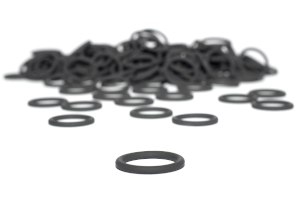FEPM O-RINGS | MATERIALS SIMPLY EXPLAINED
What are FEPM O-rings?
FEPM is a comparatively new material for sealing elements. This is a peroxide cross-linked fluorinated elastomer.
One of the main areas of application is plant engineering, where FEPM O-rings demonstrate their strengths particularly in contact with aggressive media. However, not only FEPM, but also other materials from the group of fluorinated elastomers are characterized by particularly good media resistance:
The material FEPM is also known under the chemical name tetrafluoroethylene propylene copolymer rubber.
As an alternative to the designation FEPM according to ISO 1629, the material is also called TFE / P (ASTM D1418). Practitioners are also familiar with the common trade names: FEPM O-rings can be found on the market as Aflas®.
With a high maximum temperature and very good chemical resistance, FEPM is ideal for many challenging applications. Above all, it competes with the alternatives FKM and FFKM.
In many applications, O-rings made of FEPM offer improved media resistance compared to FKM and a significant cost advantage over FFKM.

Feature | Value |
|---|---|
ISO designation | FEPM |
Trade names | AFLAS |
Chemical name | Tetrafluoroethylene rubber |
Media resistance | Good media resistance |
Temperature resistance | -10°C to +200°C |
Standard color | Black |
Standard hardness | 75 Shore A |
Industries | Oil&Gas, Automotive industry |
Production | Compression molding and injection molding |
Tolerances | DIN ISO 3601 |
Durability | 10 years |
REQUEST FEPM O-RINGS QUICKLY AND EASILY?
Almost any dimension available
Over 10,000 FKM dimensions available from stock
Offer received in record time
No minimum order values or minimum quantities
#1 The 5 most important advantages of FEPM O-rings
1. Very good chemical resistance
2. Excellent mechanical properties
3. Hardly any ageing
4. Very good paint resistance
5. FDA conformity
FEPM O-rings are characterized first and foremost by their impressive resistance to chemicals.
With acids, alkalis, complex mixtures of solvents and mineral oil-based products, the resistance profile covers many important technical media. FEPM even outperforms FKM in this respect.
The particular strength of FEPM lies in the fact that the media resistance can be combined with a high maximum operating temperature. FEPM O-rings retain their flexibility even when exposed to aggressive chemicals and high temperatures.
This gives them exactly the long service life that is important for the stable operation of interlinked technical systems in the chemical industry or paint shops.
The impressive mechanical qualities also make FEPM O-rings suitable for use under high pressures. Particularly noteworthy is the strong resistance to explosive decompression should be emphasized.
A comparison of the most important O-ring materials
Material | Temperature resistance | Chemical resistance | Elasticity |
|---|---|---|---|
NBR | -30°C to +120°C | Low | High |
HNBR | -30°C to +150°C | Medium | High |
EPDM | -45°C to +150°C | Medium | High |
SILICONE | -60°C to +200°C | Low | High |
FKM (VITON) | -25°C to +200°C | Medium | High |
FEP coated | -60°C to +200°C | High | Medium |
PTFE | -250°C to +250°C | High | Low |
FFKM | -40°C to +340°C | High | High |
#2 The 3 most common areas of application for FEPM O-rings
CHEMISTRY and PAINT industry
Production plants in the chemical industry today are highly networked.
For engineers, this means that they cannot make any concessions when it comes to the durability and reliability of sealing elements. After all, unplanned system downtimes must be avoided at all costs.
At the same time, longer replacement intervals for O-rings can also increase cost-effectiveness. FEPM O-rings have proven to be a valuable option for the challenging operating conditions in the chemical and painting industries.
Increasingly aggressive media in complex mixtures, high pressures and fluctuating temperatures: FEPM O-rings cover this extreme range in an economical way.
Diesel engines
Diesel engines used in shipbuilding carry media with additives for corrosion protection in their cooling circuit.
There is a gap in the property profile of FFKM and FKM O-rings. The corrosion inhibitors can damage FKM O-rings on the one hand. Although FFKM has the necessary durability, it is also very price-intensive.
This in turn increases the risk of leaks and thus reduces reliability. O-rings made of FEPM fill the gap: With similar media resistance to FFKM and slightly better elasticity, they provide the necessary service life.
This contributes to the already existing cost advantage of FEPM.
Steam applications
Many technical applications do not produce pure steam.
Instead, they are usually mixtures that contain small amounts of additives such as corrosion inhibitors in addition to steam.
This adds another important aspect to the generally very good suitability of FEPM O-rings for hot water and steam up to 200 degrees.
Unlike FKM, for example, FEPM has the necessary chemical resistance to these common additives in steam.
#3 What is the media resistance of FEPM O-rings?
Even within the group of fluorinated elastomers, FEPM O-rings are characterized by particularly comprehensive media resistance.
Compared to other elastomers, the combination of media resistance and suitability for use under high heat is the key differentiating feature of FEPM.
FEPM O-rings are resistant to:
- Acids
- Lye
- Complex solvent mixtures
- Amine-based additives against corrosion
- H2Sgases and oils
- Petroleum products
- Engine and gear oils
- Silicone oils
- All types of brake and power steering fluids
This general resistance profile can be further adapted to the requirements of specific applications by selecting the right FEPM quality.
There are common variants with a special focus on resistance to hot water and steam or a particular insensitivity to contact with chemicals.
The vapor resistance of O-rings made of FEPM is significantly better than their FKM counterparts. FEPM grades are also available with the necessary approvals for the food and medical industries, including FDA Title 21 and USP Class VI up to 121 degrees.
#4 What is the temperature resistance of FEPM O-rings?
FEPM O-rings have a temperature resistance of -10°C to +200°C.
The data sheets specify a general temperature range of -10 to +200 degrees in contact with air for FEPM O-rings.
This high temperature resistance is evident when testing the compression set according to DIN ISO 815. Even after a long time in air tempered to 200 degrees, FEPM O-rings largely return to their original shape.
This low permanent deformation makes a permanent, secure seal possible even under changing temperature conditions.
In the lower operating temperature range, FEPM behaves similarly to FKM or ACM. However, O-rings made of materials with significantly better low-temperature suitability are available.
At the maximum temperature, however, only VMQ, FKM and FFKM can reach similar ranges to FEPM. Certain grades of FKM O-rings can reach up to 250 degrees, while common FFKM O-rings have an upper temperature limit of 270 degrees.
#5 What are the mechanical properties of FEPM O-rings?
1. High tensile strength
2. Pronounced compressive strength
3. Low compression set
High elongation at break and pronounced compressive strength: FEPM O-rings have very good mechanical properties.
This is particularly effective under changing pressure conditions. If FEPM O-rings are relieved after a pressure peak, they return to their original shape to a high degree.
This allows them to maintain the sealing gap even under fluctuating conditions.
The pronounced tear resistance and elongation at break pay off less during use, but much more during installation.
There is only a very low risk of installation-related damage due to excessive expansion of the O-ring. FEPM O-rings are also very robust under extreme conditions: the material is one of the few that is highly resistant to explosive decompression.
While the standard quality of FEPM O-rings has a hardness of 75 Shore A the range extends from a hardness of 60 to 90 Shore A.
Greater hardness also contributes to resistance to high pressure. It prevents the risk of gap extrusion
#6 What do I have to consider when designing the groove of an FEPM O-ring?
Groove design of FEPM O-rings
1. Groove design according to DIN 3771 Part 5
2. Ensure minimum compression of the cross-section of 6% in the static case
3. Provide for up to 6% expansion over the inside diameter of the groove in the event of external pressure
4. Allow for 1 to 3% compression on the outer diameter of the groove if pressure is applied from the inside
5. 20% of the installation groove should still be free when grouted
No significant specific additional requirements need to be implemented for the groove design for FEPM O-rings.
But even so, it is no easy task for designers to weigh up technical and economic requirements when designing.
After all, more cost-intensive processing methods generally result in technically superior sealing systems. These are generally characterized by low tolerances and a high surface quality.
Assembly of FEPM O-rings
1. Groove design according to DIN 3771 Part 5
2. Ensure minimum compression of the cross-section of 6% in the static case
3. Provide for up to 6% expansion over the inside diameter of the groove in the event of external pressure
4. Allow for 1 to 3% compression on the outer diameter of the groove if pressure is applied from the inside
5. 20% of the installation groove should still be free when grouted
#7 Further important information on FEPM O-rings
Finally, we would like to answer a few questions that we are frequently asked in everyday life.
#7.1 What is FEPM material?
O-rings made of FEPM are in the same group as FKM and the high-quality FFKM O-rings.
FEPM is characterized by very good resistance to various chemicals and a wide temperature range from -10°C to +200°C.
#7.2 Is there a data sheet for the FEPM O-rings?
You can easily view the data sheet for our FEPM O-rings directly on our website and download it if you wish.
#7.3 Is there an AFLAS resistance list?
Yes, there is. If you want to check the media resistance of O-rings, you are welcome to use our media resistance list.
#7.4 What is the difference between FEPM and AFLAS
AFLAS® is a trade name for FEPM.
Accordingly, both stand for the same material: FEPM.
“I am convinced that we should share our knowledge with the world. I hope I have been able to answer all your questions. If you have any further questions, please feel free to contact us at any time. We will be happy to help you.”

Lord of the O-rings
Author of the sealing academy
